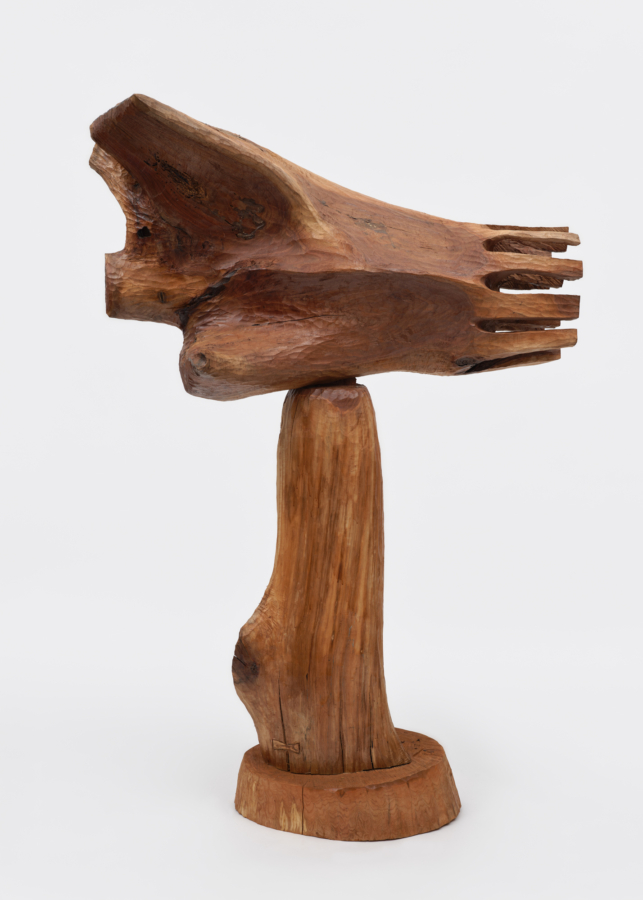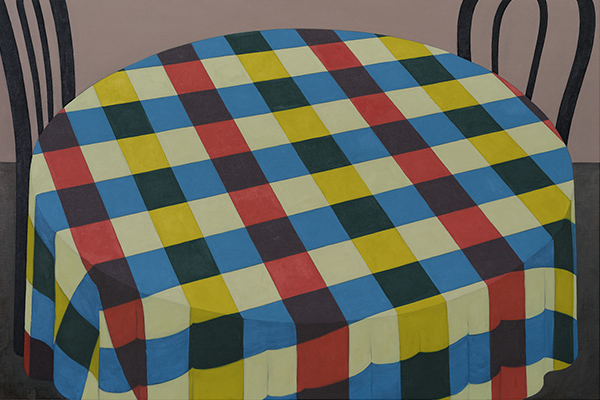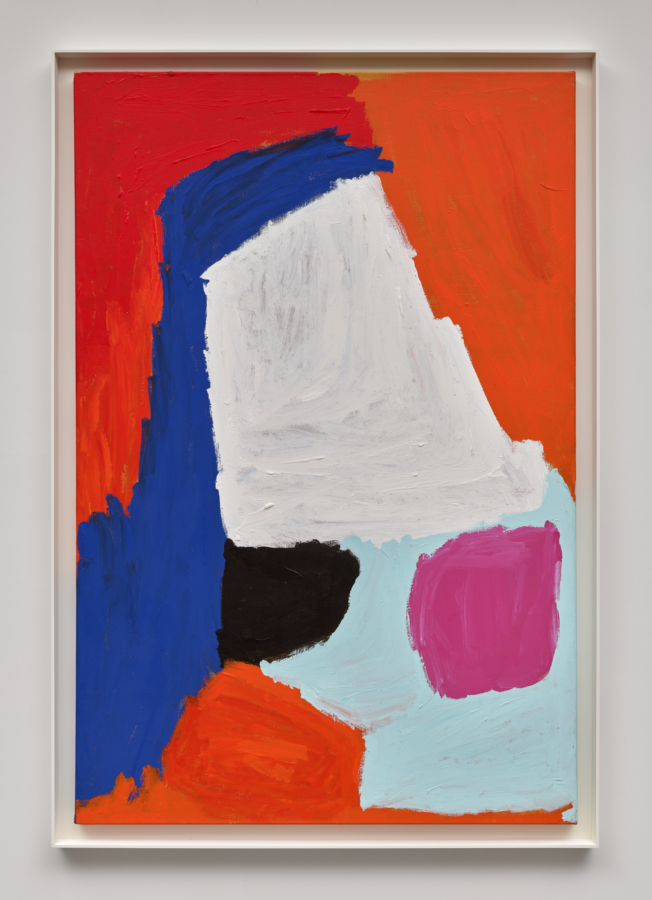August 1971
The Deluxe Show: Exhibition Catalogue, Menil Foundation, Houston, 1971.
SS: You’ve spoken, lyrically, about art that’s clear and free of obstruction. You even said free of pollution. What do you mean?
PB: It’s just art that’s clean and free and wide open, unlike the art of the fifties and forties which was cloudy. Pollock-type art-big globs that looked good but didn’t strike you as being “clean.” Clarity and order go all the way back to early Egyptian and African art, so called primitive. Looks as if they’re going to win again. Everyday simple arrangements of color and form seem to break the barrier of all of the erotic-expressionist art. Today’s art might be telling a secret about the earth’s environment. Art is becoming clean and neat. Clarity moves me. Maybe it’s a message, a prophecy. I don’t know.
SS: You seem to enjoy the sky, science-fiction, visions of galaxies and the universe.
PB: You see the sky all the time. You see great phenomena in the sky, or in puddles of oil and water on the street, that create fantastic, soft colors. Everyone who’s participated in the Deluxe Show has those qualities. The art looks simple as hell-unobstructed. Somehow the artists seem to have put those ideas into practice ahead of time.
SS: You enjoyed hanging that show.
PB: The paintings have never been in that kind of space before. They held their own. They shouted in that space’ Re-member the huge yellow Olitski and how it just seemed to scream? I was afraid that my paintings and Noland’s narrow ten-foot strips would be lost in that vast white space. Instead they seemed to get larger. They withstood, on their own. Like Danny Johnson’s piece, they seemed to grow. This is a problem the Museum of Modern Art should experiment with. They’ve crammed dozens of huge paintings into a space and made them look smaller, instead of using the opposite formula. The Whitney, too. The only museum that seems to have found the formula would be the Walker.
SS: It’s with warmth that you speak of the feeling that unites the works you chose.
PB: This selection breaks down the barriers that create this whole theory of black shows and white shows. The Deluxe show marks the very first time that good black artists share the attention and the tribute with good white artists. 1he black artists look good with them simply because they are good. All the artists in the show certainly have paid their dues.
SS: Dues?
PB: Living in poverty. Wondering where the next penny will come from to buy paint, let alone food. Begging to be exhibited. Wondering whether you’ll ever be heard, be seen. You can’t make out unless you work full time at it. You have to figure a way to make the money to give yourself the time to make that art. Now they have the money and the time to work. That didn’t come overnight. As for the blacks, this is the first generation of serious black painters in America.
SS: When did you do away with image?
PB: When I found out that Kodak can do it far better than I can.
SS: Then what happened?
PB: I kept thinking of a way to apply the paint faster in order to see more color each time I painted. Also, I saw what Olitski had done with spraying. I couldn’t do it by hand, it just wasn’t fast enough. I had to turn to a mechanical device, a spray gun. The real reason I turned to the spray gun was because it’s the only way to put the paint on fast. After working eight hours a day at Perls Galleries, that left me only four to five hours in the night to paint. With the gun I can see more color than mixing by hand. That killed my biggest enemy: my right hand. This process did away with the tremendous indulgence to create something to which I already knew the answer. With a spray gun I can’t foresee what will happen to the surface. With the hand it’s all predictable. The spray gun, you know, has a kind of mind of its own.
SS: Surface also means feeling?
PB: Yeah. The shine of the paint, the scale, the texture, the depth, the quality.
SS: What do you see when you look at the surface?
PB: The unknown, the mystery. It deals with an unknown feeling and a feeling of the unknown; something I’ve never seen before. Using brushes I was always exactly certain of the way it would look. But I don’t mean to say the spray gun is my final step.
SS: Your reverence for the unknown, is it at the root of your affinity with the artists you admire? Those you chose for the show?
PB: Yes. They’re constantly taking a risk. Noland, Caro and Olitski took their risks, and today they’re ahead, they’re famous. But others in the show aren’t. Let’s say all of the artists in this show are children pushing every day toward a new expression. They could be out tomorrow. Yeah, they’re constantly taking a risk.
SS: Peter, how did it all begin? How did it happen that you, a painter, were asked to function as curator for this spontaneous exhibition?
PB: I don’t know. Didn’t it come out of the Rice show “For Children?” Didn’t that start the dialogue with the black community in Houston?
SS: I remember. First, there was a question of putting together, hastily and informally, an exhibition of black art in a poor part of Houston; then the idea was discussed with you. Your advice was sought.
PB: That’s right. That’s when I said that no black artist of any worth will allow his work to be shown in an all black situation, even in a black neighborhood. Some artists were upset by the 1971 Whitney show of black art, from which many withdrew (I refused to be in it) on the principle that we’re artists first, artists who happen to be black. We’ve put too much of our life into our work, and we don’t want to be lumped politically. We were proven to be right, at least as far as art criticism is concerned; for you’ll remember that press coverage of the -Whitney show concentrated on black political stances. Hardly a word was said of the art itself! It embittered many artists who, happy to accept recognition from a museum devoted entirely to American art, ended up being used as a socio-political football, tossed by the white press. Many artists felt trapped and cursed themselves for not having been wiser. They felt used. Anyway, while talking to John de Menil I explained that danger. So he asked, “Well, what would you do?” I told him. Two days later he called me up at Perls: “Peter, would you be willing to put a show together?” Just like that.
SS: You liked the idea?
PB: Yes, very much. Suddenly here’s a chance for me to ex-press my ideas for everyone to see! Very few artists ever get a chance to do this, very few. You know words aren’t my medium. Art is. Here I’m given the freedom to express how I feel about today’s art by selecting what I consider to be valid. As a curator attached to no museum, I have no dues to pay to anyone, no affiliation. It’s a chance that artists are rarely given! I liked the risk: all criticism drawn upon the exhibition will have to be borne by me because the works are all my own choice. They’re just things I like to see, some-how knowing they’re right.
SS: Why Caro?
PB: Anthony Caro is really the first sculptor to make pure abstract sculpture since Gonzales and David Smith. His work still looks so strange and new, whereas Smith’s is starting to look just a little bit old. I can see it coming. Gonzales is great art but it reeks of a period. Plus I think Caro is the best sculptor alive.
SS: Who’s Wolfe?
PB: Other than the fact that he’s been working with Ken Noland and Tony Caro, helping them make sculpture for the last three or four years (he’ll be in a group show of Bennington sculptors at Emmerich downtown in the winter), he looks as though he might be one of the first to make sculpture turn up-right without looking figurative. On the other hand Steinerhas been able to make it look upright by laying it down at the same time.
SS: Upright? PB: Yeah, to make sculpture that turns itself straight up and down. The scale of it alone gives a figurative quality. It’s almost impossible to elude it. Yet, it’s pure abstraction. I think these two guys, Caro and Wolfe, have it. Steiner too. This is the first time in history that sculpture has come to the same level as painting.
SS: Level of what?
PB: Level of appreciation. Viewers are starting to appreciate sculpture as much as painting as an abstract form. In the past they were given sculptures of nudes, Maillol, Rodin, and Henry Moore figurative forms. I’m not knocking the sculpture; instead, I’m sensitive to the viewer and his acceptance of new things being done.
SS: Then why is Caro’s piece in the show called “Bull?”
PB: I’ve no idea why and how names are put on these things. It has no relevance to the art itself.
SS: What about the relevance of this show to the neighborhood people?
PB: To teenagers it’s going to be something that comes to town. They don’t understand it but it’s fun like a circus. To the older folks it’s going to be something that they don’t understand but they know they should respect it because they hear it’s important. But the young kids are really the ones that get something out of it. The kids between 7 and 1 0, maybe 12, because they haven’t yet been indoctrinated by bad art, or ethnic art which I think is bad. There’s a chance that they can read the art better than most people who frequent museums and pretend they know. They have a much better chance to appreciate the art and the space. This is all light and airy and free.
SS: Are you talking about black people?
PB: Who else?
SS: Has New York reacted to the show?
PB: Anything that doesn’t happen at the Modern Art Museum or some heavy Madison Avenue gallery goes unnoticed, as far as the media’s concerned. Which is why, once you live in the city, you get the feeling no other place exists, other than Paris and London. There’s a lot of space in Texas for a lot of things.



